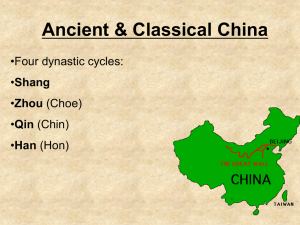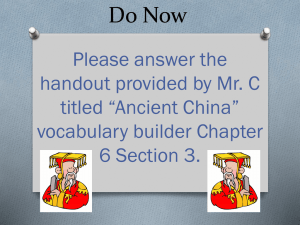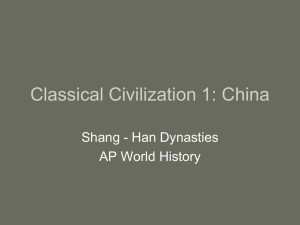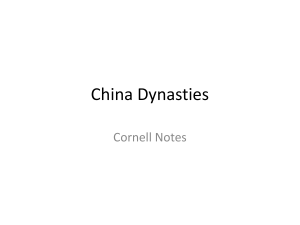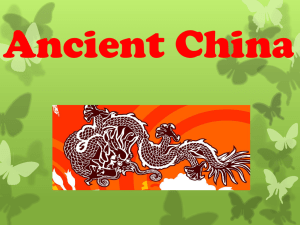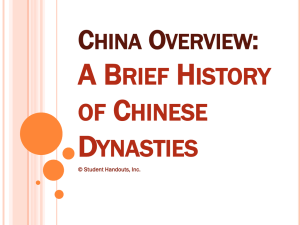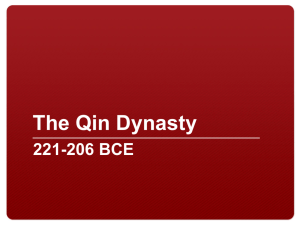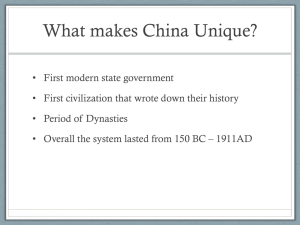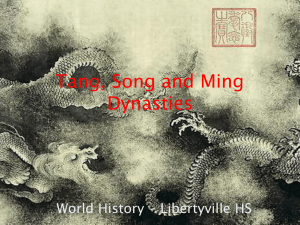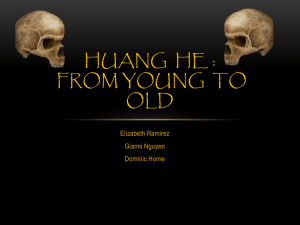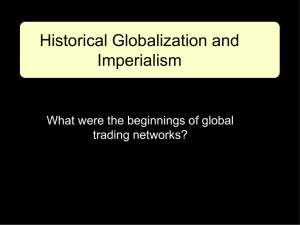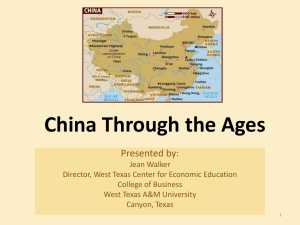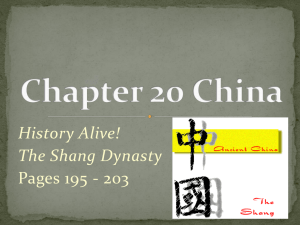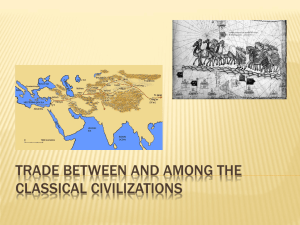Ancient China PowerPoint
advertisement
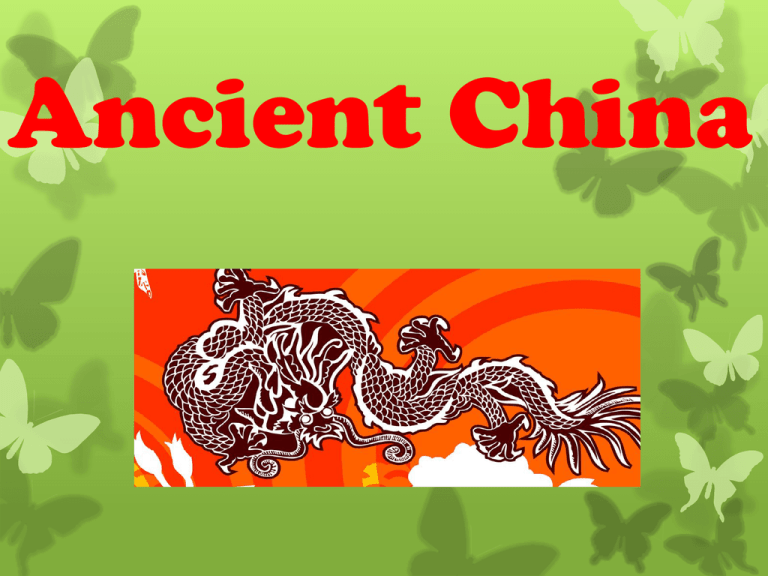
Ancient China Ancient China: Section 1 Contrasting Climate and Landforms Southern China- warm and wet as a result of the Monsoons from the South China Sea Northern- cool and dry, dependent on rivers as a source of water Located on the Eastern side of Asia Lies about same latitude lines as United States Bordered on the east by the Yellow Sea, East China Sea, and the Pacific Ocean A Varied Climate Western China: dry like Western United States Northern China: like New England (Maine, New Hampshire, Connecticut, etc.) • Wheat and millet grown in the drier northern lands Southeast China: like southern United States • Rice grown in the moist climate “The Middle Kingdom” Geographic features such as mountains , deserts and seas blocked off China from the rest of the Ancient world. North—Gobi Desert West—Taklimakan Desert, Pamir, Tian Shan, and Himalayan mountains. They only knew of the nomadic people to the North and West of them China had no knowledge of Egypt, India, Greece, Rome, etc. They were sure they lived in the center of the earth that they called themselves the “Middle Kingdom” Rivers, the Birthplace of Civilization The Huang He river and the Yangtze River would overflow. This would provided rich, fertile soil ideal for farming near the rivers. Both deposit yellow silt Chang Jiang/Yangtze located in central China Huang He/Yellow River is located to the north Farming done between the two rivers—area called North China Plain China’s Sorrow The Huang He river was also called “China’s Sorrow” because it was very unpredictable Destructive floods would come without warning At times the floods would cut new paths for the river The Bonds of Family Traditional Families- A household in ancient China might contain as many as 5 generations living together. Most privileges in a family would belong to the elders (they would make household decisions) Women were typically governed by men (their fathers, husbands or sons) Shang Dynasty Around 2000 B.C. farming settlements along the Huang He grew into cities. The beginning of Chinese culture developed. China is the oldest, longest lasting civilization in the world! Shang Kings Dynasty: line of rulers from the same family 1766 B.C. Shang family started to rule some cities. Kings were responsible for religious activities. Claimed to rule with gods’ permission Controlled central portion of North China Plain Relatives ruled distant areas Protected themselves from nomads, the Zhou, to the North and west with chariots. Shang Families Respect for family and ancestors very important Family was closely tied to religion Believes spirits of ancestors could bring good fortune to family Family paid respect to father’s ancestors by making animal sacrifices Men were in charge of the family Family Names The Chinese were the first people to have 2 names. One name was for the family, one was for the individual. In Chinese society the family name comes first. Developing Language Oracle bones— animal bones or turtle shells on which Shang royal priests used to interpret messages from the gods. Priests would make scratch marks on bones and shells—early form of writing Developing Language Continued… Pictograph system of writing developed Used simple drawings/symbols for words or ideas To barely be able to read and write must know at least 1,500 Characters in the Chinese alphabet Scribe needed to know 10,000 characters Ancient China Section 2: The Life of Confucius Philosophy: study of basic truths and ideas about the universe Confucius was the most famous and important of Chinese thinkers. Born 551 B.C. Noble but poor family Loved learning and self-taught Thought to be China’s first professional teacher Education was very expensive—Confucius charged a small fee but would also take in students who were poor if they truly wanted to learn. The Life of Confucius (cont.) Confucius wandered North China looking for rulers to follow his teachings. Was unsuccessful finding a ruler Died 479 B.C.—72 years old Felt his life was a failure. Teachings of Confucius Confucius never wrote down his teachings. Students gathered his sayings and made up a philosophy, after his death. A philosophy is a system of beliefs or values. This philosophy became known as Confucianism, one of several important philosophies of ancient China. Teachings of Confucius (cont.) Confucius’s goal—order in society. If people would behave properly to one another, order and peace would return. People should know their place in family and in society. You should respect people above and below you. Five Relationships Confucius created code of proper conduct for people. Each relationship has its own duties and own code of conduct. Relationships fall under two categories: •Proper conduct in the family •Proper conduct in society Father and Child Elder Brother and Junior Brother Husband and Wife Friend and Friend Ruler and Subject Proper Conduct Society Authority should be respected. Ruler should lead in a right, moral way and subjects will obey. Ruler should treat subjects with respect. Family Confucius believed respect and good behavior started at home. Filial Piety— respect for one’s parents and ancestors Impact of Confucius Confucius teachings became basic training for members of civil service groups. Civil service group of people who work for the government. Before Confucius ideas, government posts given to sons of important people. Afterward jobs given on merit. Candidates had to pass official exams. (Exams were based on Confucius teachings.) Legalism Philosophy: study of basic truths and ideas about the universe Legalism: a belief that rulers should use the legal system to force people to obey laws These people believed a strong government was the answer to China’s problems. Strict Laws and Harsh Punishments Legalists’ beliefs: • Human nature is naturally wicked, and people must be forced to do good. • Government must pass strict laws to control the way people behave • Harsh punishments make people fear doing wrong. An Increase of Government Control Shang Yang wanted people to turn in others who broke the law. He thought that people who did not report lawbreakers should be punished. Legalists: • thought those who did their duty should be rewarded. • did not want people to complain about government. • Favored arresting people who questioned the government or taught different ideas. • Thought rulers should burn books that contained different philosophies or ideas. Daoism & The Way Is said to be started with Laozi, “Old Master”. Book of teachings called Dao De Jing (The Book of the Virtue) Believes “The Way” or Dao guides all things. All creatures except humans follow Dao Humans must learn to live in harmony with nature and with their inner feelings to find the way. Following the Way Daoists accepted things as they were. Did not become involved with government Tried to understand nature and live in harmony with it. Yin Yang: two things that interact with one another • Yin (black): all things cold, dark, and mysterious • Yang (white): all that is warm, bright, and light. • Compliment each other • Helps people understand how the fit into the world. Ancient China Section 3: Chinese Dynasties What’s a dynasty? A sequence of powerful leaders within the same family Chinese history is measured and described through the various dynasties. Chinese Dynasties • • • • • • • • • • • • • • Xia Dynasty About 1994 BCE - 1766 BCE Shang Dynasty 1766 BCE - 1027 BCE Zhou Dynasty 1122 BCE -256 BCE Qin Dynasty 221 BCE - 206 BCE Early Han Dynasty 206 BCE - 9 AD Xin Dynasty 9 AD - 24 AD Later Han Dynasty 25 AD - 220 AD Three Kingdoms - Period of Disunion 220 AD - 280 AD Sui Dynasty 589 AD - 618 AD Tang Dynasty 618 AD - 907 AD Song Dynasty 969 AD - 1279 AD Yuan Dyansty 1279 AD - 1368 AD Ming Dynasty 1368 AD - 1644 AD Manchu or Qing Dynasty 1644 AD - 1912 AD The First Dynasty? Xia or Shang? According to legend, the Xia Dynasty is the first Chinese dynasty that existed from 1994 BCE - 1766 BCE. However, there is no archeological evidence to prove the existence of the Xia dynasty. Therefore, the Shang Dynasty is the first known dynasty with historical evidence Cycle of Chinese Dynasties (dynastic cycle) 1. A new dynasty rises. -A strong local ruler defeats the others -He often adds land to China -Believed to have mandate (or approval) from the heavens 2. The new dynasty rules 5. A period of local violence follows -New dynasties fight for power and restore peace and order -Restores peace -Chooses local officials -Makes reforms 4. The dynasty falls -Dynasty is believed to no longer have mandate from the heavens -Rebellions put an end to the weakened dynasty 3. The dynasty grows weak -Rules don’t do the hard work of running the empire -Tax the people too much -Can’t deal with disasters such as famine, earthquakes, invasions The Shang Dynasty Arose sometime after 1700BC Some of the finest bronze work of Ancient China First to introduce a Chinese writing language Who was Shi Huangdi? • Ruler of the Qin Dynasty • Originally, his name was Zheng • “cracking his long whip, he drove the universe before him… His might shook the four seas.” • By 221 Zheng extended his rule to cover most of modern day China • Renamed himself Shi Huangdi or “first emperor” The Qin Unified China Shi Huangdi stopped battles within warring states. Conquered rival states Drove out nomadic invaders China grew the largest it had ever been! The Qin Unified China Cont. • Huangdi killed or put into prison anyone who opposed him Wanted total control of China: • Took land away from defeated noble families • Forced nobles to live at the capital so he could watch them • This weakened noble families’ power. He divided China into districts, and each district was run by the emperor’s most trusted officials Organizing the Government Shi Huangdi built highways and irrigation projects. • Forced peasants to work on projects such as building roads • These roads helped his army to rush to the scene if a rebellion occurred. • Set high taxes for peasants to pay Unifying the Culture • Shi Huangdi ordered one type of currency (money) to be used throughout China. This united China. • Ordered a common system of weights and measures • He tried to control the thoughts of people by outlawing the ideas of Confucius and other thinkers. • Killed 460 government critics and Confucianists • Ordered the burning of books unless they were about medicine, technology, or farming Great Wall of China Throughout China’s history, people were constantly worried about attacks from the north. Different towns built walls to help protect their borders. Shi Huangdi set out to connect those walls by building the Great Wall of China Great Wall of China Cont’d Shi Huangdi ordered farmers, merchants (peasants), and criminals to form an army of about 300,000 workers Many died and the people resented the emperor. Great Wall linked many small walls that were built during the time of the Warring States. Earliest walls built of earth, later stone and brick were used. When finished the wall stretched for 1,400 miles. (The distance from Washington DC to Denver, Colorado) Terra-cotta Army In 1974, 8,000 life-size statues were discovered in Northern China. For over 2000 years these soldiers protected the tomb of Shi Huangdi No 2 statues are identical With his underground army Shi Huangdi planned on ruling a second empire in the afterlife End of the Qin Dynasty Shi Huandi died in 210 BC This started four years of chaos and civil war Marked the end of the Qin dynasty The Han Dynasty One of the rebels that helped overthrow the Qin dynasty was Liu Bang Liu Bang became the 1st emperor of the Han dynasty by 202B.C. The stable government of the Han dynasty lasted about 400 years Han Government Liu Bang kept Qin policies of central government, but lowered taxes. Made punishments less harsh. Peasant men owed the government a month of labor/work a year on government projects. Peasants built roads, canals, and irrigation projects. Han Government Cont… Bureaucracy: network of appointed officials that assist in government Officials helped Liu Bang enforce rules. Bureaucrats put family members and trusted people in local government positions. Set up a system of tests to find the most educated and ethical people for the imperial bureaucratic state. • Tested people on their knowledge of Confucianism. Empress Rules Liu Bang died 195 B.C. Widow, Empress Lu took the thrown for their young son. Outlived son and continued to put babies on the throne so she could rule for them. When she died in 180 B.C. all her family members were killed. Wudi- The Warrior Emperor The Han Dynasty reached its peak under the rule of Liu Bang’s great grandson Wudi Wudi (descendent of Liu Bang) ruled the Han empire from 141-87 B.C.E. Made improvements to the Great Wall Extended Chinese territory Made many military conquests including southern Chinese provinces, northern Vietnam, and northern Korea. Chased nomadic invaders out of northern China China was almost as large as modern day China. Collapse of Han Dynasty The Han empire faced rebellions, peasant revolts, floods, famine, and economic disasters, but stayed in power until 220 C.E./A.D. After Wudi’s death the Han dynasty slowly began to fall apart Warlords (leaders of armed local bands) took control Daily Life in Han China Majority of society lived and worked on farms. Farmers lived in one to two story houses in villages near their farm. Barns, pigsties, and storage buildings were located in the village. Rich farmers had ox to pull their plows while poor farmers had to pull the plows themselves. Daily Life in Han China Cont… Farmers wore simple clothing and sandals like today. Clothing was stuffed like quilts for colder weather. Northern farmers grew wheat or millet. Southern farmers grew rice. Families kept vegetable gardens for additional food. Fish and meat were expensive so people ate small portions. City Living Cities were centers of trade, education, and government. Merchants, craftspeople, and government officials lived in the city. Cities were crowded and had lots of entertainment • Included musicians, jugglers, and acrobats Some cities had street gangs. Achievements of Ancient China Section 4: The Silk Road A trade route that went from China to the Mediterranean Sea It was a series of routes that covered more than 4,000 miles The Silk Road Cont’d Crossing the Silk Road was dangerous, travelers were easily killed by desert sandstorms Few travelers made the entire journey, generally goods were passed trader to trader Once they reached the Mediterranean goods such as silk were shipped to Ancient Greece, Rome, India, and Egypt. Silk Road received its name from silk, made only in China Silk is a luxury fabric around the world. Cultural Diffusion: The spread of ideas and customs. The silk road was also a way of spreading ideas. Buddhism spread from India into China via the silk road Cultural diffusion also was traded on the Silk Road. For example: • Military methods • Buddhism • Western cultural styles • Art • Silks • pottery Silk Road Cont’d The Spread of Buddhism During Han Dynasty Buddhist monks took the Silk Road spreading the religion to China, Japan, and Korea. Chinese Buddhists modified the religion to fit their traditions. Influential Ideas and Beliefs Confucianism Daoism Confucianism remained important in Chinese government and education. Had a lasting influence. Ideas about social duty are still important to villages. Became influential philosophy in Japan, Korea, and Vietnam. By 6th century became religion with priests, rituals, and volumes of writings. Remained primarily a Chinese belief. Chinese Inventions and Discoveries Agricultural Improvements Silk The plow and farm tools increased China lacked gold and silver. crop production Important to trade silk for this For example: scarcity • Collar harness • Wheelbarrow • Iron plow • Watermill Silk can be dyed brightly and is long lasting. 1 lb. silk equals 1 lb. of gold/silver Paper Books used to be made out of silk. 105 A.D./C.E. paper was invented by china Made it less expensive for everyone. Important in a culture that valued learning.
